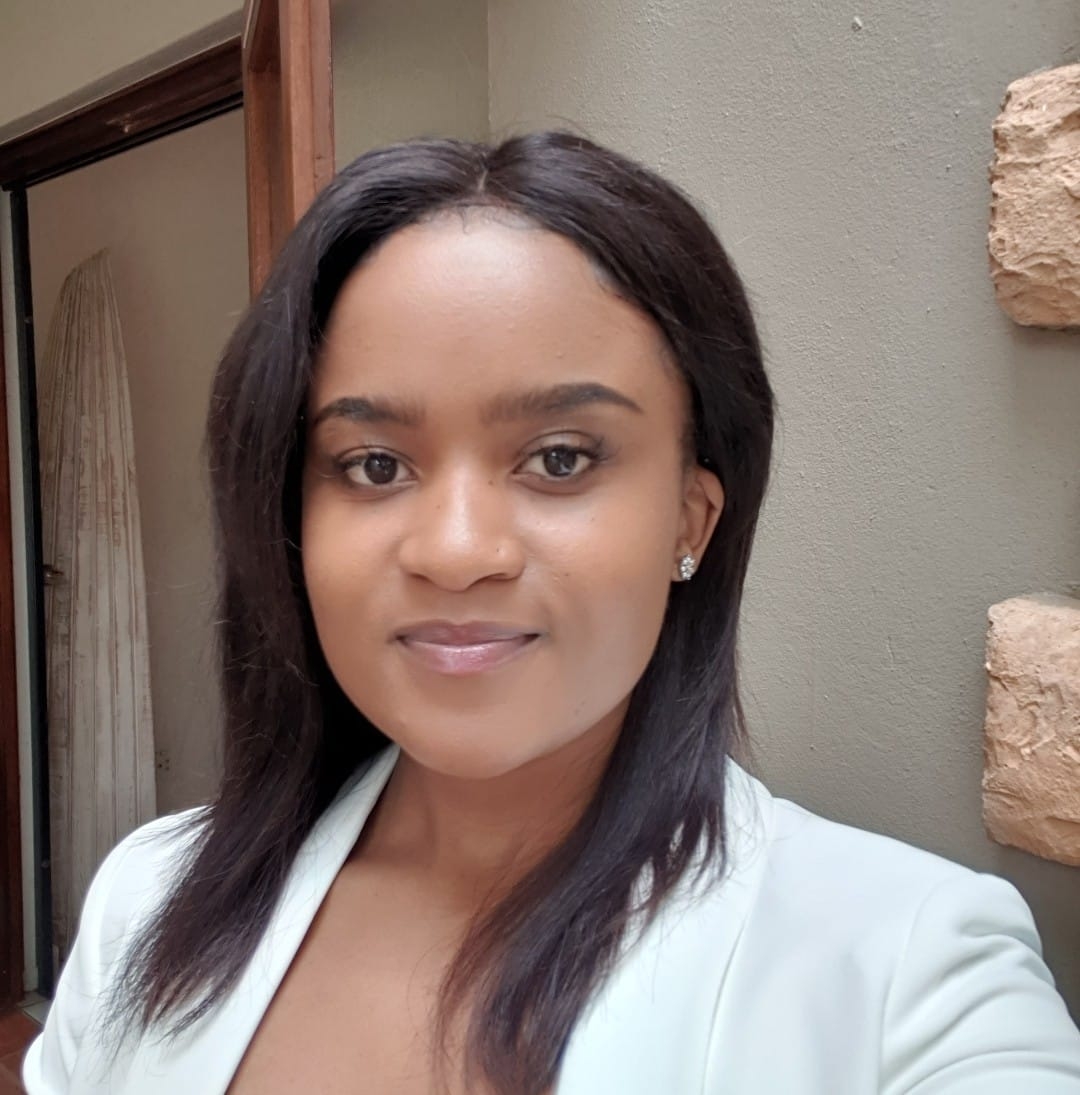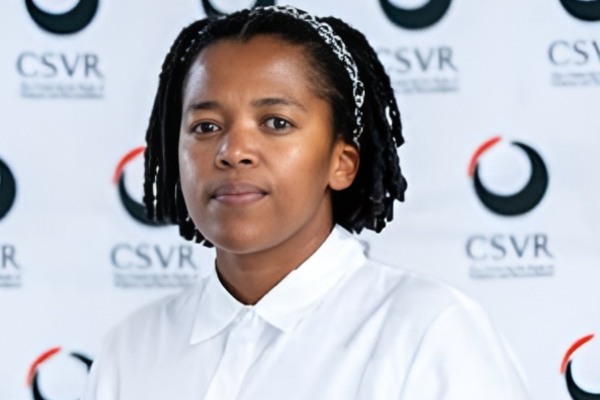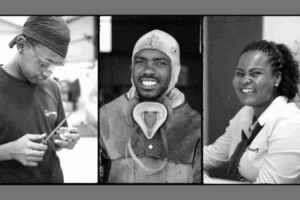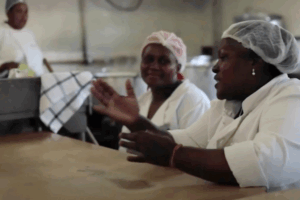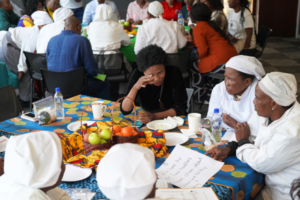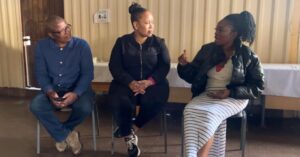As Research Manager at the Centre for the Study of Violence and Reconciliation, Nomancotsho Pakade is invested in women’s narratives, black histories, and participatory approaches to knowledge production.
You’ve been deeply involved in activism and have held formal roles focusing on gender-based violence, queer identities, and women’s leadership. Could you please tell us about yourself and your current role at CSVR, and what drives you in your work and activism?
I think it’s always important, as part of holding each other and ourselves accountable, to continuously be reflecting on the work that we are doing. I am a researcher by profession, and I’ve always been interested in documenting narratives. I am invested in women’s narratives, in black histories, and in participatory approaches to knowledge production. In my earlier work posts, if I wasn’t working as a researcher, I was coordinating knowledge production. But all my work of research is nested within social justice. All the research that I’ve done speaks to evidence, either policy interventions or advocacy initiatives, and that’s the joy.
In my current role as a research manager, my mandate is to advance African thought leadership across our four strategic thematic areas of Transitional Justice, Gender-Based Violence, Collective Violence, and State-Led Violence. My role is to engage with as many African countries, practitioners, and policymakers as possible, and also vulnerable groups, either through participatory methods or whether to inform an intervention.
We currently have four programs; Gender, Advocacy, Mental Health and Psychosocial Support, and Research. Our research work feeds into the other interventions. When we do advocacy in transitional justice, we need to understand the context and the partners we work with. We are multidisciplinary in that we have researchers, psychosocial supporters, legal expertise, and community mobilisers. And this is how we try to move with each intervention that we have. We also pride ourselves in being community centered and believe that the people we work with are the best knowledge bearers who know how to fix the problems they are facing. In doing my work, I write from a space of solidarity more than anything else.
Can you speak more about your research around Gender Based Violence and Harassment?
One of the things that are key to the work we do is ensuring that it is also accessible to different audiences. To do this, we have a mixed approach of producing infographics and reports, media engagements, and most importantly, holding dialogues and returning to the communities before we publish anything.
In South Africa, rape is an invisible part of the apartheid legacy. As a country, we are quite limited in how we engage GBV because we are very silent on the class-related and racial aspects of it since the dawn of democracy. This is something that I’m still trying to work through. According to Sue Armstrong:
“When we started investigating, we discovered that rape, particularly of black women, was so prolific in South Africa that it was just accepted by everybody, social workers, doctors, policemen, and even the victim herself. A black woman's life was considered valueless and what had happened to her was unimportant. We wanted to question that assumption. Rape is abhorrent and cannot be condoned, whomever the victim is. Gender, violence and rape have thus been perceived as marginal issues, which at best, could divert attention from the struggle against racism.”
So, this is the foundational work we have been doing, and the gap we have been responding to.
Violence in Schools
I am very invested in education, and basic education is one of the things that keeps coming up in the different work that I’ve done. For example, while I was at Action Aid South Africa, I led the program on sexual violence in schools. At the time, there were a lot of limitations in the implementation of that National School Safety Framework.
In 2011, CSVR and the South African Council of Educators (SACE) wrote a report looking at violence in schools, and later, when we came out of COVID, we did what we called a National Scoping Exercise of violence in schools to gain an understanding of the regression that happened during the pandemic in terms of the fragmented service delivery of GBV work.
One of the things that came up, specifically in Gauteng, was the prevalence of schools that were seen as ‘troubled schools’, and riddled with high crime, high violence, substance abuse, and teenage pregnancy. Since then, we’ve been working with at least ten schools, and we are seeing the rise of suicide in schools. And a lot of this speaks to how young people are subjected to violence, both as victims of violence, but also as people who live in a perpetual state of violence. So, we did an exercise social mapping exercise where we worked with Grade 8 and Grade 10 learners in trying to design interventions on how best to support them.
One of the things in those exercises was that we asked the learners, “Draw your path as you leave the gate from home, right to the school, and then tell us the type of violence you’ve seen or that you’ve been subjected to.” What we found is that, for a lot of them, as they leave the gate, they are faced with the effects of the high unemployment rate in South Africa that results in bullying from young men at the street corners and outside taverns. The violence also happens during school where fights and bullying happen at a high rate. Accessing toilets is also a problem, and some learners are expected to pay to access them. There’s also cyberbullying, humiliation, and emotional abuse from the teachers. Some of the learners talked about how they would see dead bodies in the streets. These are the sites that they know symbolise the violence that makes them vulnerable.
All of these realities require a more collective approach. One of the questions that we ask local municipalities is, how are the gender, women and youth resources from the integrated developmental plans mobilised for school safety committees? Another question is, if we have so much money coming into the country for GBV, how do we know that it’s reaching the communities? We ask these questions when we issue recommendations across the stakeholders. We’re looking at the types of services to say that part of the challenge with the GBV work is that it’s clustered and it’s also short term. So, focusing on responses and less on prevention is essential.
Femicide
We have done a study on femicide which involved looking into the definitions and the narratives of femicide. We know, for example, that a lot of women are being killed through the use of firearms. We also know that in rural communities, livestock theft and other criminal activities form part of the challenges. Communities are not well versed in understanding the notion of femicide. People just see it as GBV, and it’s still very much limited between intimate partner violence, but there are different moving parts. For example, the issue of witchcraft and people’s understanding of it as a gendered killing of women is limited.
In this area, a lot of our work was just trying to expand how people understand and see femicide, and also trying to have a sense of some of the community centered approaches. How does the community understand it? When a dead body is found, what are the processes followed? Do they know what happens to any of these cases eventually? In the past two years after doing the national scoping, CSVR funded about 25 Community Based Organises (CBOs) that we really thought were critical from communities across the provinces to support the continuation of their services. Key to the recommendation is also looking at improving the intersecting crime prevention and social responses.
Are there intersections between care work and GBV in the communities that you work in?
Yes, there certainly is a link between care work and GBV in communities. If we strip everything down, historically, care work has been associated as women’s work. So, we’re talking about domesticity, we’re talking about holding space, we’re talking about the hidden economy, whether we’re talking about family formations or whether we’re talking about servicing of the bigger community. As a feminist and as someone who’s interested in women’s narratives, it comes out in different ways. I think it’s a bit salient. At the core of the two notions or expressions of GBV and care work is that they sit uncomfortably and oppressively on women as gendered subjects. So even if we can say men are also affected by violence, global research and statistics show that 80% of the time, men are the perpetrators of GBV. There are different kinds of victims across, for example, elderly women, people living with disabilities, and the queer community, but, if we look at the numbers, it is women who are being violated.
The same applies to care work. If we look at domestic work historically in what it has been in South Africa and the global south more broadly, it has been the dehumanisation of black women as property and as subjects. There is a strapping of power, and there is certainly a vulnerability that touches on women, in both these areas. So, in terms of the work that I’ve done, I’ve written an unpublished piece reflecting on domestic work and its effect on families. I know of a case of a woman whose mom, a domestic worker, had died on her way to assist her employers at a wedding they were attending. The context was that the whole family flew down to Cape Town and she was required to travel by road on a bus. As an older woman at the time, she was ailing and preparing to retire, but went along. Unfortunately, shortly after arriving at the Cape Town bus station, she died from deep vein thrombosis after sitting too long.
The interesting part about that for me, that made me want to do the research, was how the family, they didn’t even come to the funeral. They didn’t want to pay anything towards the funeral. They didn’t even see her. I started interviewing people my age who are also researchers and knowledge makers, who are children of domestic workers. I wanted to understand how their mom’s social status had affected them. Part of their trauma was seeing their mom’s kindness or care in gentle ways that was afforded white children and not them. That really messed up with their identity in how their moms were being treated and how their employers’ children were elevated as part of the main household. So, there is an erosion when we’re looking at the disruption of domestic work, specifically within the family, and the disconnect within the family. I don’t think we’ve done enough work on that trauma.
But when we look at it broadly in terms of care work, and GBV, there are some incidences that speak to harassment. The issue of underpaying especially non-South Africans and domestic workers exposes them to more vulnerability and exploitation. They are being underpaid and are experiencing a lot of harassment in the workplace. I think my political position in terms of care work sits in the 5 Rs, to say that we need to understand or at least recognise care work as a form of work that requires rights. Post-Covid, we have come to realise that people are lonelier, suffering from psychosocial issues, and nations are aging. There’s going to be a burden of care in that sense. So, part of the solution is finding ways to reduce that burden of care specifically for women and so finding ways to redistribute that in terms of collective care and responsibility, but also rewarding care. We need to start looking at it in that way because, when you take away all of the work that’s being done by carers, there’s not much that’s left behind. Care workers keep people going, quite literally. And yes, that sits right in the middle of violence, whether its economic violence or gender-based violence.
In terms of mentoring women leaders, is there anything that you're doing in your personal capacity? I know that you've done a lot of work with the Simon Nkoli Collective, but can you speak about women's leadership and how you continue to contribute towards it?
Right now, my investment is on supporting and working with young and emerging scholars largely through research, knowledge management, systems, advising, offering technical support. In small ways, I try to support the young women that I work with by giving them greater responsibility, exposure, and ensuring that they’re able to engage different audiences. And part of it is enabling room for people to make mistakes as part of their growth, but also enabling a learning environment for people to push themselves and surprise themselves in terms of what they have. I also read people’s work as a critical reader, whether we’re talking about PhD proposals or other forms of writing, I continue to be their critical reader. I also facilitate, sometimes for free, within the civil society space, whether we’re talking strategies, or talking about young women, I essentially try to use the knowledge that I have and share it. We have a long history of thinkers.
My biggest thing is contributing to black women’s intellectual projects as doers and as thinkers. I also believe in collective leadership. In practice, that means sharing in the resources that I have, whether it’s intellectual work or opportunities. That is the type of leadership that is needed, where people are showing up with their resources and skills and being intentional about what we support. I think there would be a greater impact in that way.

